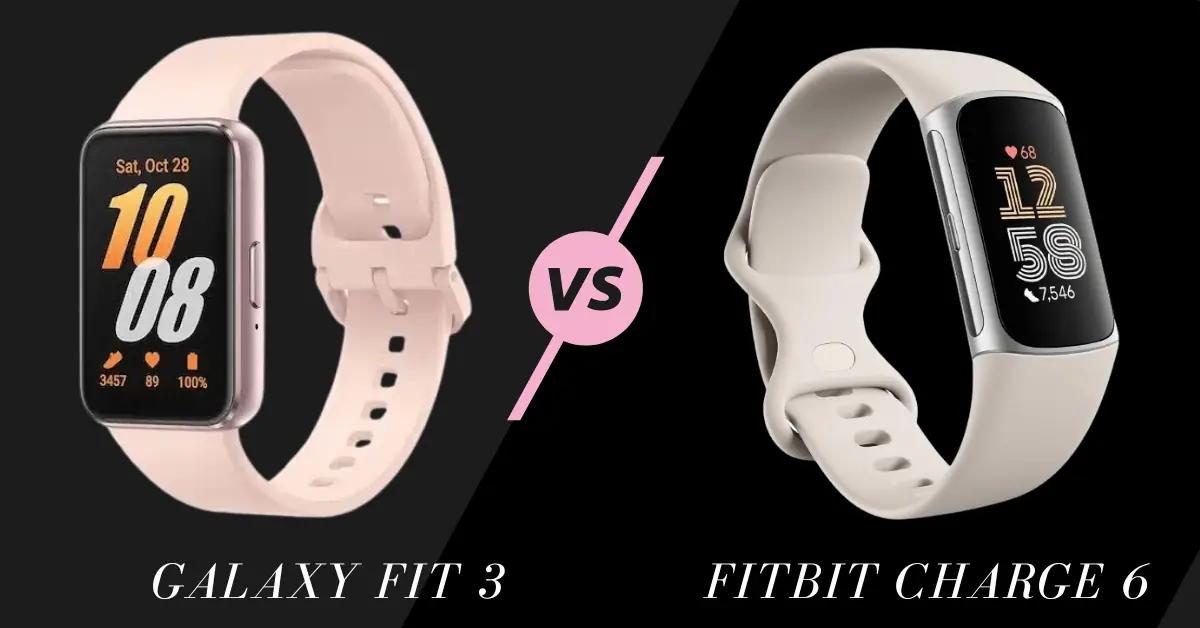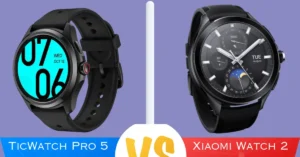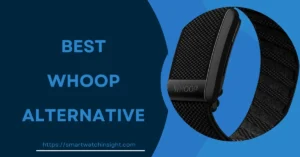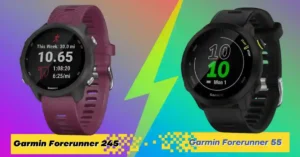Selecting the ideal fitness tracker is similar to finding a workout partner—someone who can inspire, monitor your progress, and get you moving. With their approaches, the Fitbit Charge 6 and Samsung Galaxy Fit3 both seek to be that dependable companion. The Fitbit Charge 6, due in September 2023, is focused on general well-being, while the Galaxy Fit3, which launched in February 2024, keeps your budget in mind.
These two competitors stand out in the world of must-reads about the best fitness trackers and health tech.
Now, let’s get started! We’re going to dissect their styles, investigate their health-tracking potential, examine their features more closely, and determine which one offers the best value. Get ready for an informative journey into the details of these fitness companions!
Samsung Galaxy Fit3 vs Fitbit Charge 6 Spec
| SPECIFICATION | 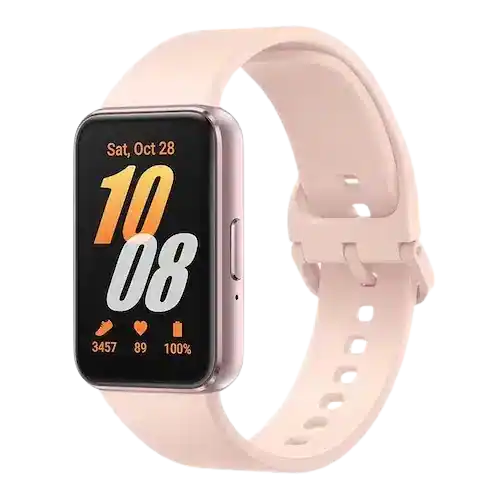 | 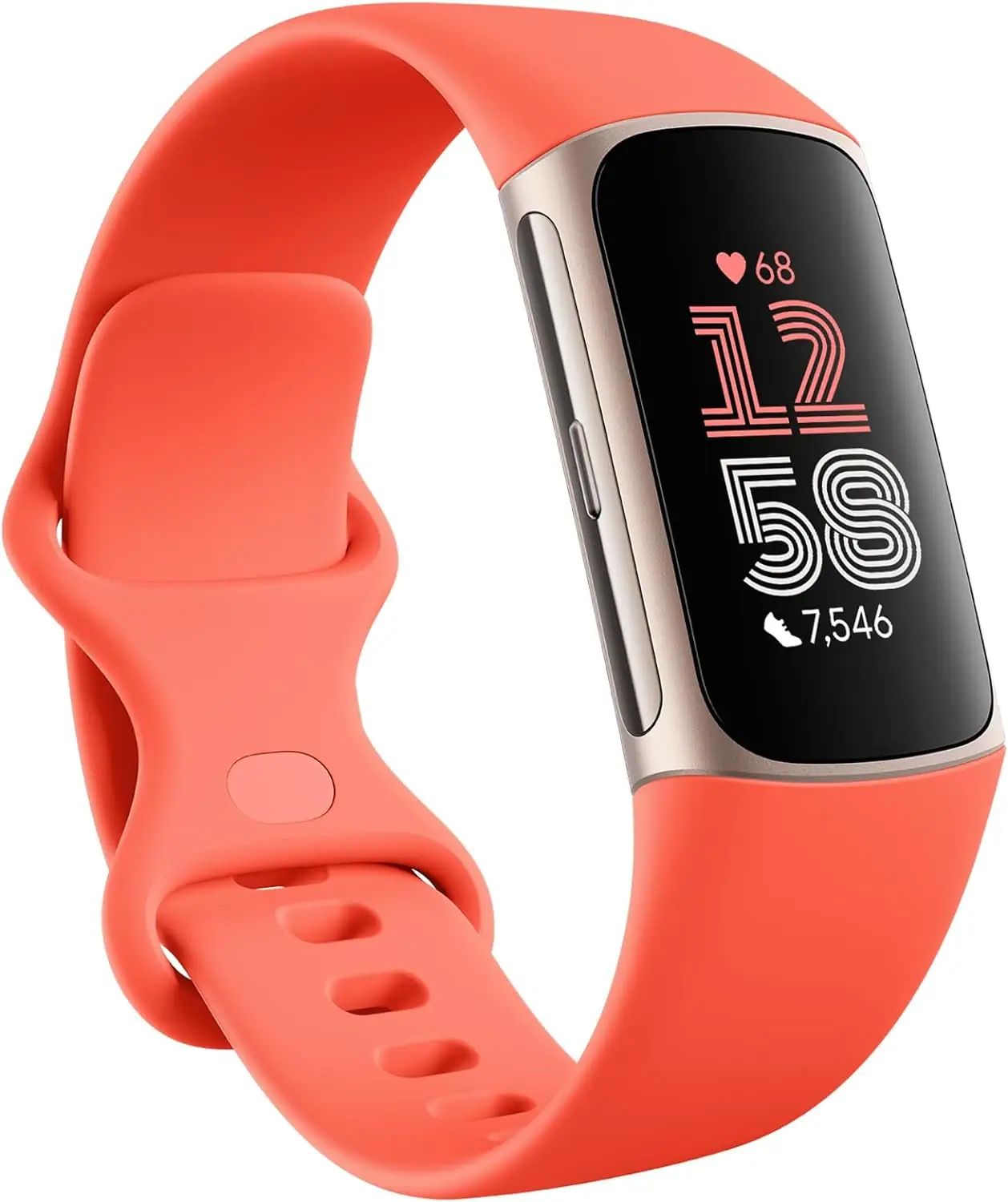 |
|---|---|---|
| SAMSUNG GALAXY FIT3 | FITBIT CHARGE 6 | |
| Display Type | AMOLED | AMOLED |
| Size | 42.9 x 28.8 x 9.9mm | 36.78mm x 23.1mm x 11.2mm |
| Shape | Rectangular | Rectangular |
| Screen Size | 1.6 inches | 1.04 inches |
| Resolution | 256 x 402 pixels | 260 x 170 pixels |
| Case Material | 2.5D glass (display), Aluminium (body) | Lightweight material, aerospace-grade aluminum case, Corning Gorilla Glass 3 display, anodized aluminum housing and buckle |
| Number of Physical Buttons | 1 physical button on the side | 1 physical button on the side |
| Weight | 36.8 grams | 37.6 grams |
| Sensors | Accelerometer, gyroscope, heart rate, SpO2, barometer, ambient light sensor | 3-axis accelerometer, Optical heart rate monitor, Pulse Ox, Multipurpose electrical sensors compatible with ECG app & EDA Scan app, Ambient light sensor |
| Water-Resistance | 5 ATM + IP68 | 5 ATM |
| GPS | Connected GPS | Built-in GPS, Glonass |
| Built-in Speaker | No | No |
| Microphone | No | No |
| Contact less Payment | No | Yes (Goolge Pay, Goolge Wallet) |
| Music Storage | No | No |
| Connection | Bluetooth 5.3 | Bluetooth, WiFi |
| Cellular Connectivity | No | No |
| Battery Type | 208 mAh Li-po | Li-po |
| Battery Life | Up to 14 days (typical usage). Supports fast charging, reaching 65% battery in just 30 minutes | Up to 7 days, or up to 5 hours with GPS |
| Operating System | FreeRTOS | FitbitOS |
| Colors | Prism Crush White, Pink, Dark Gray | Obsidian, Porcelain, Coral |
| Price | View On Amazon | View On Amazon |
Design and Build Quality
The aesthetics and comfort of a fitness tracker play a significant role in user satisfaction. The Samsung Galaxy Fit3 and Fitbit Charge 6 both offer visually appealing designs with distinct features.
The Galaxy Fit3, boasting a sleek glass display and aluminium body, exudes a sense of premium craftsmanship. This combination not only contributes to its stylish appearance but also enhances the device’s overall durability.
On the other hand, the Fitbit Charge 6 prioritizes lightweight materials, incorporating aerospace-grade aluminium and Gorilla Glass 3.
This design choice not only reduces the overall weight of the device but also aligns with eco-conscious values, a consideration increasingly important for environmentally aware consumers.
In terms of size, the Galaxy Fit3 opts for a slightly more significant form factor, providing users with a more substantial wrist presence.
This could appeal to those who appreciate a bolder, smartwatch-like visual experience. In contrast, the Charge 6 focuses on a more compact and sleek design, catering to users who prefer a discreet yet functional wearable with ample screen space.
Both devices maintain simplicity in button design, featuring a single physical button on the side. This streamlined approach ensures ease of navigation and convenience for users during daily interactions with the device.
Display, Colors, and Water Resistance
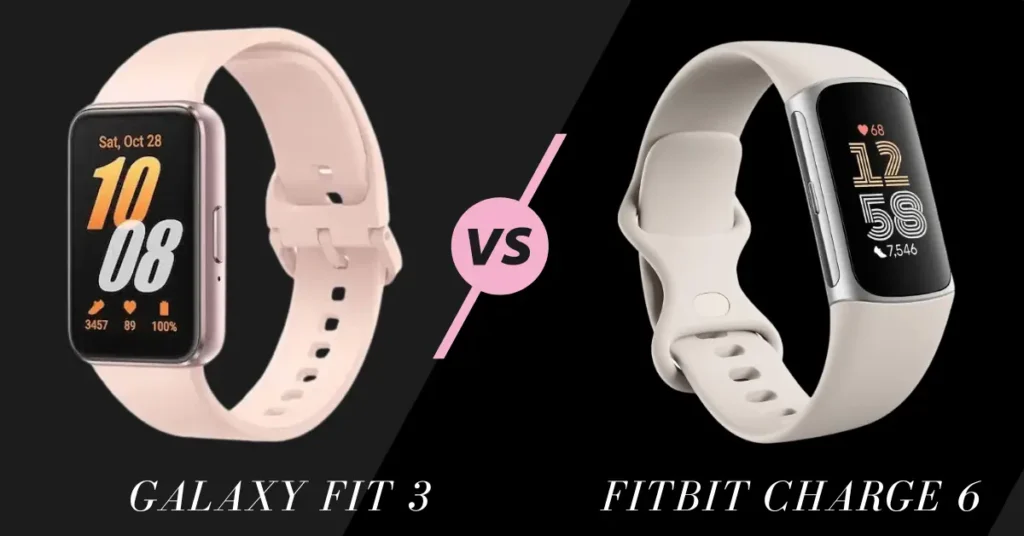
The display is a crucial element of any wearable device, impacting user experience and readability. The Samsung Galaxy Fit3 boasts a spacious 1.6-inch AMOLED display, providing a visually immersive experience.
The larger screen not only enhances the overall viewing area but also contributes to a more engaging and user-friendly interface. This is particularly advantageous for those who prioritize a vibrant and expansive display for their fitness tracking needs.
Both the Galaxy Fit3 and Fitbit Charge 6 incorporate colourful and vivid displays, ensuring readability even in outdoor settings. The inclusion of AMOLED technology enhances colour reproduction, contributing to a visually pleasing interface that complements various lighting conditions.
Water resistance is a crucial consideration for fitness trackers, as users often engage in activities involving water, such as swimming or showering.
Both the Galaxy Fit3 and Charge 6 come equipped with a 5 ATM rating, indicating suitability for water-related activities. This feature ensures users can wear their devices without worry during workouts or daily routines involving water exposure.
Colour options allow users to personalize their fitness trackers to match their styles and preferences. The Galaxy Fit3 offers choices such as Prism Crush White, Pink, and Dark Gray, providing a diverse range of options.
Similarly, the Fitbit Charge 6 offers Obsidian, Porcelain, and Coral, catering to different aesthetic tastes.
Health and Wellness Features
The health and wellness features of fitness trackers have become increasingly sophisticated, catering to users who seek a holistic understanding of their physical well-being. The Samsung Galaxy Fit3, while not as health-focused as the Charge 6, offers a robust suite of fitness tracking features.
The Fit3 includes essential health monitoring features such as heart rate tracking, sleep analysis, blood oxygen level monitoring, floor counts, and activity recognition. These features are fundamental to modern fitness wearables, providing users with insights into their daily activities, sleep quality, and overall cardiovascular health.
The Fitbit Charge 6 takes a more holistic approach to wellness, incorporating additional sensors and features that extend its capabilities beyond basic fitness tracking.
The inclusion of an EDA (Electrodermal Activity) sensor allows the Charge 6 to track stress levels by measuring changes in the skin’s electrical conductivity. This feature is precious for users interested in stress management and maintaining mental well-being.
Furthermore, the Charge 6 features a dedicated skin temperature sensor, providing users with information about variations in their skin temperature. This data can offer insights into trends related to health and wellness, contributing to a more comprehensive understanding of the user’s physiological state.
Fitbit’s Premium subscription enhances the Charge 6’s capabilities by unlocking features such as the Daily Readiness Score. This score helps users make informed decisions about whether to prioritize workout intensity or focus on recovery based on factors such as sleep, activity, and heart rate variability.
The Galaxy Fit3, while not offering the same level of depth in wellness features as the Charge 6, provides a solid suite of tracking capabilities suitable for users primarily focused on fitness monitoring.
Sensors and Technology
The technological capabilities of fitness trackers are crucial in providing users with comprehensive health and activity insights. Both the Samsung Galaxy Fit3 and Fitbit Charge 6 incorporate a range of sensors, offering users a wealth of information related to their well-being.
Standard sensors shared by both devices include an accelerometer, gyroscope, heart rate sensor, SpO2 sensor, barometer, and ambient light sensor. These sensors collectively contribute to accurate tracking of physical activities, heart rate monitoring, sleep analysis, and environmental awareness.
The Fitbit Charge 6 distinguishes itself by introducing additional sensors that enhance its health monitoring capabilities. These include multipurpose electrical sensors for ECG and EDA scans, along with a dedicated skin temperature sensor.
The inclusion of these sensors allows the Charge 6 to provide users with more detailed insights into their health, stress levels, and variations in skin temperature.
For location tracking, a crucial feature for outdoor activities, the Fitbit Charge 6 incorporates built-in GPS (and GLONASS). This eliminates the need for users to rely on their smartphones for accurate location data during exercises like running, biking, or hiking.
In contrast, the Galaxy Fit3 utilizes connected GPS, requiring synchronization with a smartphone for accessing location data.
Samsung Galaxy Fit3 vs Fitbit Charge 6 Battery Life
Battery life is a pivotal factor influencing the overall user experience, especially for individuals who prefer a low-maintenance and long-lasting wearable.
The Samsung Galaxy Fit3 impresses with its substantial 208 mAh Li-po battery, delivering up to an impressive 13 days of typical usage. This extended battery life is noteworthy, considering the advanced features and the presence of a large display on the device.
Additionally, the Galaxy Fit3 emphasizes fast charging capabilities, allowing users to reach 65% battery capacity in just 30 minutes. This feature minimizes downtime, ensuring a seamless and uninterrupted user experience. The integration of fast charging aligns with the needs of users who prioritize quick and efficient charging solutions.
In comparison, the Fitbit Charge 6 maintains a consistent battery life of up to 7 days, mirroring the performance of its predecessor. Fitbit’s expertise in balancing features and power consumption ensures that users can rely on the device for a reliable week-long experience without frequent recharging.
While the Charge 6 does not highlight fast charging as a prominent feature, its focus is on delivering a consistent and reliable battery life that aligns with users’ expectations for a health and fitness tracker.
Smartwatch-type Features
The integration of smartwatch-like features enhances the versatility of fitness trackers, offering users additional functionalities beyond health and activity tracking. The Fitbit Charge 6 seamlessly integrates with the Google ecosystem, providing users with practical and everyday utilities.
The Charge 6 supports Google Wallet for contactless payments, allowing users to make transactions directly from their wrists. This feature enhances convenience, especially for individuals who prefer the simplicity of wrist-based payments during their daily activities. Additionally, Google Maps integration provides turn-by-turn navigation, further enriching the user experience with practical navigation tools.
Beyond payment and navigation, the Charge 6 supports notifications, music control for Spotify, and quick replies to messages (for Android users). These features contribute to a more comprehensive and interconnected user experience, resembling the convenience and functionality of a smartwatch.
On the other hand, the Galaxy Fit3, while lacking NFC for contactless payments, offers a range of smartwatch capabilities. It provides notifications for calls, messages, and apps, along with music control when connected to a smartphone. The integration with the Samsung ecosystem ensures a cohesive experience for users of Samsung smartphones and services.
However, it’s essential to note that the Galaxy Fit3 may not offer the same level of integration with broader services like Google Maps or Wallet as found on the Charge 6. The choice between the two devices may depend on individual preferences regarding the ecosystems and services they are already invested in.
Samsung Galaxy Fit3 vs Fitbit Charge 6 Price
Pricing plays a crucial role in the decision-making process for many consumers, influencing the perceived value and affordability of a fitness tracker. The Samsung Galaxy Fit3 holds a significant advantage in terms of price, making it an attractive option for budget-conscious users.
In countries where it is available, the Galaxy Fit3 typically retails at around $70. When compared to the Fitbit Charge 6, which typically has a recommended retail price (RRP) of $160, this indicates a significant price difference. However, it’s essential to consider that prices can fluctuate due to sales, promotions, and regional variations.
While the Galaxy Fit3 offers a cost-effective solution for those seeking basic fitness monitoring and essential features, the Charge 6’s higher price tag may be justified for users looking for advanced health tracking, additional sensors, and a more comprehensive set of smartwatch-like features.
Conclusion: Fitbit Charge 6 and Samsung Galaxy Fit3
In conclusion, both the Samsung Galaxy Fit3 and Fitbit Charge 6 present compelling options for users seeking fitness trackers with a blend of health tracking, fitness features, and smartwatch-like conveniences. The choice between the two devices depends on individual priorities, preferences, and budget considerations.
Samsung Galaxy Fit3
- Price is a Major Factor: The anticipated lower price of the Galaxy Fit3 makes it a strong contender for users prioritizing affordability without compromising essential fitness tracking features.
- A Slightly Larger Display is a Priority: The Fit3’s larger screen may appeal to individuals seeking more viewing space and a visually immersive experience.
- Safety Features are Important: The inclusion of fall detection and SOS capabilities in the Fit3 provides added peace of mind, especially for users engaging in outdoor activities alone or with health concerns.
- Comprehensive Health Tracking is Key: The Charge 6’s additional sensors, such as EDA, skin temperature readings, and built-in GPS, offer a more holistic approach to health monitoring, providing users with detailed insights.
- Built-in GPS is Essential: For users who prioritize independent tracking of outdoor exercises without relying on a smartphone, the Charge 6’s built-in GPS provides a valuable advantage.
- NFC Payments and Smartwatch Features are Appealing: The Charge 6’s integration with the Google ecosystem, supporting NFC payments and offering smartwatch-like features, makes it a more versatile choice for those seeking advanced functionalities.
Fitbit Charge 6 Price on Amazon
Both the Samsung Galaxy Fit3 and Fitbit Charge 6 offer excellent value, making either one a worthwhile investment. The Galaxy Fit3 caters to users who value affordability, safety features, and a larger display. In contrast, the Charge 6 is a premium option for those seeking comprehensive health tracking, independent GPS, and a richer set of smartwatch-type functions.
Ultimately, the decision comes down to personal preferences, priorities, and the specific features that align with individual needs. Regardless of the choice, both fitness trackers provide valuable tools for users looking to monitor their health, track fitness activities, and enhance their overall well-being.
Aslo see :- Samsung Galaxy Fit 3 vs Fit 2: Which Fitness Tracker Is Right for You?

